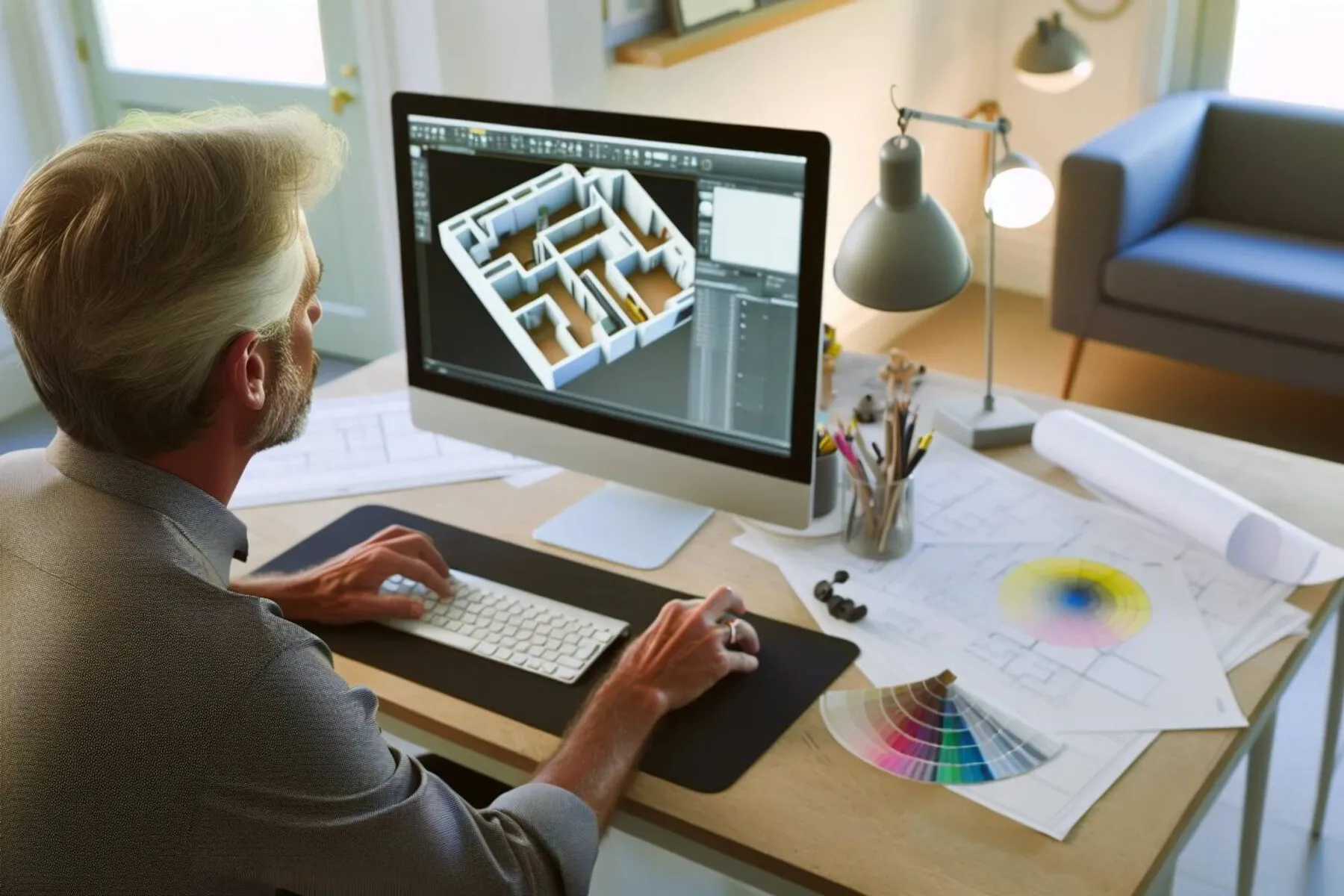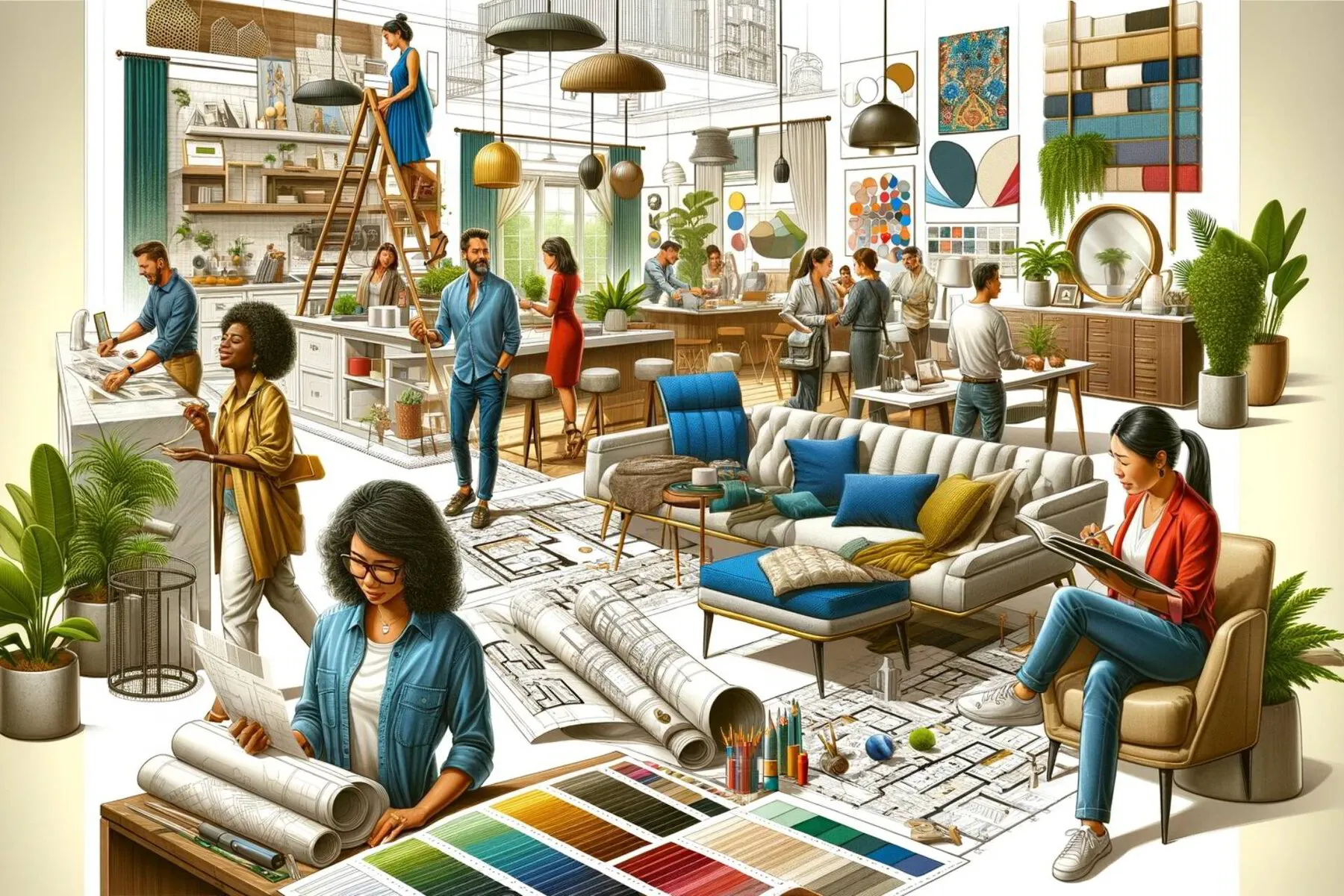Have you ever wondered what does an interior designer do?
They create stunning and functional spaces that cater to their clients' unique needs and preferences. It takes a combination of creative vision, technical expertise, and collaboration to transform an ordinary room into an extraordinary living or working environment.
In this blog post, we’ll take you on a journey through the world of interior design, highlighting the various roles, skills, and specializations that define this dynamic profession.
📘 Key Takeaways
- Interior designers create aesthetically pleasing and functional living spaces that meet client needs.
- The profession requires creative vision, technical expertise, project management skills, and knowledge of design software.
- Interior design can significantly increase a property’s value by enhancing its functionality, aesthetics, and appeal.
The Role of an Interior Designer
Interior designers are skilled professionals who expertly combine space planning, aesthetics, and functionality to create visually appealing and practical spaces. They work closely with clients to ensure their needs and preferences are met.
Some of the responsibilities of interior designers include:
- Creating sketches and drawings
- Organizing the necessities in a home to maximize its functionality
- Ensuring projects are completed according to the agreed-upon schedule and budget
To excel in this multifaceted profession and become an interior designer, a bachelor’s degree or an interior design certification is highly recommended, along with a range of artistic, creative, and intuitive skills.
Understanding Space Planning
In interior design, space planning is a fundamental tool to optimize the use of space in a room or building, considering factors like circulation, accessibility, and comfort.
The primary principles of space planning include:
- Measuring the space and creating a digital floor plan
- Defining the purpose of the space
- Determining the flow of the space
- Utilizing existing elements
- Being judicious in filling the space while considering zoning, circulation, proportions, scale, flexibility, and harmony
Space planning, a blend of science and art, results in functional interior spaces that satisfy the occupant’s needs and objectives, including interior space optimization.
Aesthetics and Functionality Combined
Achieving the perfect balance between aesthetics and functionality is a key aspect of interior design. Designers must create visually appealing spaces while also serving their intended purpose.
This requires incorporating:
- cohesive furniture
- ergonomic design
- a harmonious living space
- blending design styles
Interior designers often utilize computer-aided design (CAD) software programs to produce detailed drawings with precision.
This blend of art and practicality ensures that interior spaces look stunning and provide occupants with a comfortable and efficient environment.
The Client-Designer Partnership
A successful client-designer partnership is built on clear communication, understanding the client’s vision, and the ability to translate that vision into a functional and beautiful space.
Communication is critical when collaborating with an interior designer. It is particularly crucial in the planning stages of a project. Selecting a designer who considers your preferences and comprehends your desired outcome is essential, as you will be living with the end result.
By fostering a strong and collaborative partnership, both clients and designers can achieve their design goals and create spaces that truly reflect the unique needs and aspirations of the occupants.
Educational Pathways to Becoming an Interior Designer
Starting a career as an interior designer requires completing an accredited interior design program, gaining practical experience via internships, and securing professional certification.
Courses in drawing, lighting design, architecture, environmental science, professional practice, and computer drafting are crucial to any interior design education program.
These subjects help the student develop theoretical knowledge and practical skills related to interior design.
A degree in interior design can assist in acquiring internship positions and networking prospects to expand one’s professional network.
Securing the National Council for Interior Design Qualification (NCIDQ) exam certification is a fundamental step toward becoming an acknowledged and successful interior designer.
📘 Related Reading: How to Become an Interior Designer: A Comprehensive Guide
Accredited Interior Design Programs
Accredited interior design programs, which have earned interior design accreditation, equip students with the knowledge and skills needed to excel in the industry.
These programs cover core components such as:
- Interior design principles and concepts
- Drawing and sketching techniques
- Computer-aided design (CAD) software
- Color theory and application
- Space planning and furniture selection
- Aesthetic and functional aspects of interior design
They also instruct on various design principles like:
- color theory
- space planning
- furniture and material selection
- lighting design
- textile and material knowledge
- sustainability and environmental design
- ergonomics
- design history and theory
For a prosperous career in interior design, it is indispensable to master these principles and techniques, along with the latest materials and software.
The Importance of Internships
Internships offer valuable hands-on experience and networking opportunities, helping aspiring designers build portfolios and establish professional connections.
As an interior design intern, you’ll gain exposure to a wide range of tasks and responsibilities, such as:
- Programming
- Consulting
- Strategic planning
- Conceptual designs
- Space planning
- Presentations
- Design development
- Production
Leading interior design companies like Gensler, Perkins & Will, and HOK offer internships, providing invaluable opportunities for interns to learn from experienced professionals and make a lasting impression in the industry.
A portfolio is fundamental for showcasing an interior designer’s best work to potential clients and hiring managers, highlighting their talents and aesthetics with high-quality photos and project examples.
Essential Skills for Interior Design Success
Thriving as an interior designer necessitates a variety of skills, including expertise in:
Design software like Revit, AutoCAD, 3DS Max, SketchUp, and MagicPlan for creating detailed plans and visualizations of interior spaces
Project management for effectively managing timelines, budgets, and resources
Creative problem-solving for finding innovative solutions to design challenges
Project management skills are also necessary for managing projects from inception to completion, coordinating with other professionals, and meeting deadlines.
Lastly, creative vision and problem-solving abilities enable designers to develop innovative solutions for various design challenges, ensuring that their work stands out and leaves a lasting impression on clients.
Mastering Design Software
Design software, such as CAD, is essential for creating detailed plans and visualizations of interior spaces.
Interior designers use design software for space planning by generating digital floor plans, evaluating how the space will be utilized, and transforming CAD drawings into 2D or 3D renderings.
Common software options include:
Mastery of these tools is a critical skill for any successful interior designer, allowing them to bring their creative visions to life and impress clients with accurate and visually appealing designs.
Project Management Prowess
Project management skills are crucial for interior designers.
They are responsible for:
- Overseeing projects from conception to completion
- Coordinating with other professionals
- Meeting deadlines
- Budgeting and invoicing
- Goal setting
- Effective communication
- Utilizing suitable tools for organization and collaboration
Several project management tools are available for interior designers, such as:
By honing their project management skills, interior designers can ensure the smooth execution of their interior design projects and the satisfaction of their clients.
Creative Vision and Problem-Solving
Creative vision and problem-solving abilities are vital for interior designers, enabling them to develop innovative solutions for various design challenges.
Designers must be able to think outside the box, brainstorm, visualize, and find clever solutions to design problems.
They can enhance their problem-solving abilities by assembling various ideas and sources of motivation, recognizing issues, formulating multiple solutions, expressing themselves effectively, and obtaining certifications and additional training.
By harnessing their creativity and problem-solving skills, interior designers can create unique and inspiring spaces that truly stand out and capture the imagination of their clients.
The Work Environment of Interior Designers
Interior designers work in a variety of settings, including offices, showrooms, and on-site at projects. They must be adaptable and versatile, as their work environment can vary depending on the project and their deadlines.
In addition to office work, designers often visit job sites to oversee construction and installation, ensuring that their design plans are successfully implemented and meet client expectations.
Collaboration with other design professionals, such as architects and contractors, is also a crucial aspect of the interior design profession, as it ensures the successful execution of design plans and the creation of cohesive and functional spaces.
Office Space vs. Field Work
The work of an interior designer often involves a combination of office work and fieldwork. In an office setting, designers focus on tasks such as creating design plans, communicating with clients, and managing projects.
On the other hand, fieldwork involves visiting job sites, collaborating with contractors, making design decisions, and ensuring the plan is implemented accurately.
This balance between office and field work enables interior designers to effectively utilize both their creative and technical skills while ensuring the successful execution of their designs.
Collaborating with Other Design Professionals
Collaboration with other design professionals is essential for ensuring the successful implementation of design plans and meeting client expectations.
Interior designers often work with architects, builders, and commercial interior design professionals to create cohesive and functional spaces that cater to their clients' unique needs and preferences.
By forming a unified team and maintaining clear communication, interior designers can effectively collaborate with other professionals to craft a consistent design that considers all relevant factors and ensures a harmonious appearance both internally and externally.
Specializations Within Interior Design
Many interior designers, also known as interior decorators, can opt to specialize in different areas like commercial or residential design and keep abreast of emerging trends in the industry.
Each specialization offers unique challenges and opportunities, allowing designers to hone their skills and cater to specific client needs. So, what exactly does an interior designer do in these specializations?
Diversifying their skill sets and keeping up with new design trends allows interior designers to innovate and evolve continuously, ensuring their work stays fresh and relevant in an ever-changing industry.
Commercial vs. Residential Focus
Commercial and residential design focuses on different types of spaces, each with unique requirements and challenges. Commercial interior design creates functional and visually appealing spaces for businesses and brands, emphasizing user experience.
In contrast, residential interior design is tailored to suit the requirements and preferences of individuals or families in their residences, focusing on aesthetics, functionality, comfort, and livability.
By understanding the differences between commercial and residential design, interior designers can better serve their clients and create spaces that truly reflect their unique needs and aspirations.
Emerging Trends in Interior Design
New trends in interior design, like sustainable and inclusive design, provide fresh opportunities for designers to innovate and enhance their skills.
Sustainable design involves creating interior spaces that are environmentally friendly, socially responsible, and economically viable. This trend is gaining popularity due to the growing awareness and concern for environmental sustainability.
On the other hand, inclusive design considers the requirements and preferences of people of all abilities and ages, ensuring that interior spaces are accessible and functional for all.
By staying abreast of the latest trends and incorporating them into their work, interior designers can continue pushing their profession's boundaries and creating aesthetically pleasing and sustainable spaces.
The Impact of Interior Design on Property Value
Interior design can significantly impact a property’s value by improving functionality, aesthetics, and overall appeal, making it more attractive to potential buyers or renters.
By considering factors such as lighting, paint colors, and layout, interior designers can enhance the atmosphere and practicality of a space, boosting its attractiveness to potential buyers.
Research has indicated that good interior design can considerably impact property valuation, with potential increases of up to 20%.
By enlisting the services of a professional interior designer, homeowners can add substantial value to their property and ensure a higher return on investment for their design projects.
Navigating the Business of Interior Design
Interior designers must navigate various aspects of the business, including building codes, inspections, and marketing their services.
Building codes and inspection regulations ensure that designs are functional and legally compliant, requiring designers to remain informed of the latest codes and standards to guarantee compliance with the law.
In addition, effective marketing strategies help designers showcase their work, attract new clients, and establish a strong reputation in the industry.
By mastering these business aspects, interior designers can ensure the success and longevity of their careers in the competitive world of interior design.
Deciphering Building Codes and Inspection Regulations
Understanding building codes and inspection regulations is key to ensuring the safety and compliance of design projects.
Building codes determine requirements for:
- Structural integrity
- Fire safety
- Energy efficiency
- Accessibility
These codes affect design decisions such as materials, layout, plumbing, wiring, and outdoor modifications.
Interior designers must be aware of these codes and regulations, including:
- Accessibility codes
- Fire safety codes
- Electrical codes
- Plumbing codes
This is to ensure their designs meet the established standards and regulations of the local building authorities. By adhering to these regulations, interior designers can guarantee their design projects' safety, efficiency, and legality.
Marketing Strategies for Design Services
Effective marketing strategies are vital for interior designers to display their work, draw new clients, and build a solid reputation in the industry.
A well-crafted portfolio visually represents a designer’s work, highlighting their talents, aesthetics, and ingenuity.
Networking is also crucial for establishing professional connections and staying informed of the latest trends and opportunities in the industry.
Additionally, interior designers can effectively utilize SEO to promote their services through the following strategies:
- Creation of a well-designed and user-friendly website
- Conducting keyword research
- Optimizing website content
- Constructing backlinks
- Utilizing local SEO
- Leveraging social media
- Monitoring performance
By employing these marketing strategies, interior designers can expand their clientele and ensure the continued success of their business.
Summary
Throughout this blog post, we have explored the multifaceted world of interior design, delving into the roles, skills, and specializations that define this dynamic profession.
From space planning and aesthetics to client collaboration and business acumen, interior designers must master a wide range of skills and knowledge to succeed.
By staying informed of the latest trends, embracing new design challenges, and continually honing their craft, interior designers can create spaces that captivate, inspire, and ultimately elevate the quality of our daily lives.
And if you want to learn more about interior design and its exciting possibilities for your home, don't forget to check out the rest of our interior design blog!
Thanks for reading our article on how to become an interior designer!
📘 Related Reading: The 7 Elements of Interior Design
Lara Harding
Lara is a supporting author @ DIY Home Comfort. She's an experienced interior designer and decorator and a full-time mom. You can find out more about her here.
Frequently Asked Questions
What do interior designers actually do?
Interior designers make indoor spaces functional, safe, and beautiful by determining space requirements, selecting decorative items such as colors, lighting, and materials, and working on technical aspects like moving interior walls or dictating the change of plumbing.
They must be able to draw, read, and edit blueprints to create a safe and aesthetically pleasing space.
What are the 5 duties of an interior designer?
As an interior designer, your duties involve undertaking a design project from concept to completion, determining client goals and requirements for the project, interpreting and translating customer needs into rough plans, negotiating fees and schedules, and researching and deciding on materials and product sourcing.
What is the difference between an interior designer and an interior decorator?
Interior Design involves creating functional spaces within a building, while Interior Decoration is the furnishing or adorning a space with fashionable or beautiful things. Interior Designers may decorate, but Decorators do not design.
How can interior design increase the value of a property?
Interior design can significantly increase the value of a property by improving functionality, aesthetics, and overall appeal, making it more attractive to potential buyers or renters.
What specializations are available within the field of interior design?
Interior design is a diverse field, offering specializations in residential and commercial design, allowing designers to stay on top of the latest industry developments.










